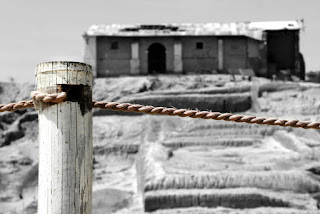Free Access To Narihualá Site Museum
CATACAOS, Peru - If you are arriving into Piura City this Sunday, April 7th, or the first Sunday of every month, and you want to connect to the Pre-Hispanic past of Piura Valley, the Narihualá Site Museum is a good choice, just located 3 miles away or 10 minutes by car from Catacaos City.
The Narihualá Site is an archaeological spot formed by a huaca (pronounce "waka") or sacred place built at the top of a hill, pressumibly Tallán origin, over which the Spaniards built a Catholic temple as part of idolatry extirpation policy adopted when they conquered Peru in 1532 AD.
There is no consensus among archeologists about the nature of Narihualá yet. They suppose it was a military-political center, or a religious one, or a combination of both. What they have clear is that Narihualá could be the most important place for Tallán Culture, that fluorished in actual Piura and Tumbes Regions lowlands between 500 AD and 1470 AD.
The Discentered Direction of Culture (DDC) annunced there will be some cultural activities scheduled on April 7th as a show of folkloric dance, a performance of Peruvian music box (cajón peruano), and an exposition by Catacaos-based painter women. "We invite different groups of music, dance, painting, theater to show ttheir art in Narihualá," DDC's director Carolina Vílchez Carrasco explained. The entrance will be free only this Sunday and the first Sunday of every month between 9:00 and 14:00.
The Narihualá Site Museum offers a permanent exposition of the Pre-Hispanic and Colonial past in Lower Piura Valley, as well as the actual artistic and cultural evidences of the zone. The tour includes to visit around the Huaca of Narihualá throuh an informative panels circuit. If you need a simultaneous translation guide, you can contact us previously at factortierra@gmail.com.
It is a Peruvian policy that all the museums administered by the Ministry of Culture openn their doors for free the first Sunday of every month.
The photos on this post were provided by DDC.
The Narihualá Site is an archaeological spot formed by a huaca (pronounce "waka") or sacred place built at the top of a hill, pressumibly Tallán origin, over which the Spaniards built a Catholic temple as part of idolatry extirpation policy adopted when they conquered Peru in 1532 AD.
There is no consensus among archeologists about the nature of Narihualá yet. They suppose it was a military-political center, or a religious one, or a combination of both. What they have clear is that Narihualá could be the most important place for Tallán Culture, that fluorished in actual Piura and Tumbes Regions lowlands between 500 AD and 1470 AD.
The Discentered Direction of Culture (DDC) annunced there will be some cultural activities scheduled on April 7th as a show of folkloric dance, a performance of Peruvian music box (cajón peruano), and an exposition by Catacaos-based painter women. "We invite different groups of music, dance, painting, theater to show ttheir art in Narihualá," DDC's director Carolina Vílchez Carrasco explained. The entrance will be free only this Sunday and the first Sunday of every month between 9:00 and 14:00.
The Narihualá Site Museum offers a permanent exposition of the Pre-Hispanic and Colonial past in Lower Piura Valley, as well as the actual artistic and cultural evidences of the zone. The tour includes to visit around the Huaca of Narihualá throuh an informative panels circuit. If you need a simultaneous translation guide, you can contact us previously at factortierra@gmail.com.
It is a Peruvian policy that all the museums administered by the Ministry of Culture openn their doors for free the first Sunday of every month.
The photos on this post were provided by DDC.





Comentarios
Publicar un comentario